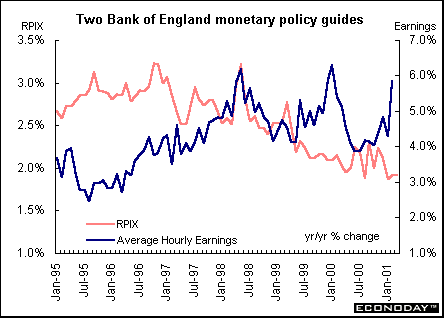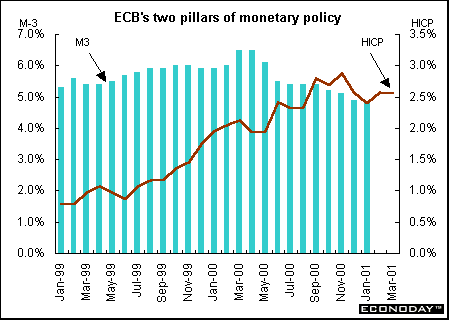Most major central banks' primary monetary policy goal is to contain inflation. That is, they set a specific number or range in which inflation must remain. Other goals such as sustained growth are secondary. The two most prominent banks that rely on inflation targeting are the European Central Bank and the Bank of England. The ECB is mandated by treaty to target inflation, while the Bank of England must target inflation at a rate set by the Chancellor of the Exchequer. Both the ECB and Bank of England use a specific numerical inflation target.
The Bank of England's Monetary Policy Committee (MPC) uses two major economic gauges to measure inflationary pressures. Price inflation is measured by the retail price index excluding mortgage interest payments or RPIX. Similar to the U.S. consumer price index, interest sensitive mortgage rates are eliminated from the measure. The RPIX has been running consistently under the Bank's 2.5 percent inflation target for almost 2 years. Another key indicator for the MPC is average hourly earnings as a measure of labor market inflation. Average hourly earnings have fluctuated around the 4.5 percent target. Most of the overshoot last year was attributable to high bonuses in the financial services sector, especially around the millenium. .

To measure the rate of inflation, the ECB relies on its "two pillars of monetary policy": the harmonized index of consumer prices (HICP), which has a 2 percent target, and M-3 money supply, which has a targeted growth rate of 4.5 percent. Anything above the targets is considered inflationary. The HICP generally has been above the 2 percent target since the beginning of 2000, while money growth is finally approaching its target after being distorted upward by the introduction of euro.

The ECB's zealous adherence to inflation targeting is being questioned as Germany, the EMU's largest economy, shows distinct signs of weakening in production and business sentiment. However, consumer prices show no sign of easing either, especially in Germany and Italy. A combination of the weak euro and climbing energy prices has conspired to push inflation up to 2.6 percent, where it has been languishing for many months. The weak euro exacerbates already high energy costs because oil is priced in dollars.
Businessmen and politicians alike are concerned that the myopic monetary policy focus on inflation has gotten in the way of supporting flagging EMU growth. They question the ECB's arrogance about EMU growth prospects. The Bank is confident that the EMU, because of its size, is insulated from deteriorating U.S. and Japanese growth. The ECB's job is complicated, no less by the markets' lack confidence in its policies and by its own desire to establish its independence from politicians, Federal Reserve policy, and the markets.
One wonders if both the ECB and Bank of England put too much confidence in a monetary policy based only on an inflation target. Neither the U.S. Federal Reserve nor the Bank of Japan set an inflation target, although the Bank of Japan has been urged to do so as one way to end the deflationary spiral that has been plaguing their economy. However, the U.S. Federal Reserve might be better off with their more general objective, which allows explicitly for economic stabilization so long as this can be achieved without touching off a fresh inflationary wave. But there is no magic in the Fed's approach either, or even in the instincts of Alan Greenspan, its chairman.
Anne D. Picker, International Economist, Econoday
|